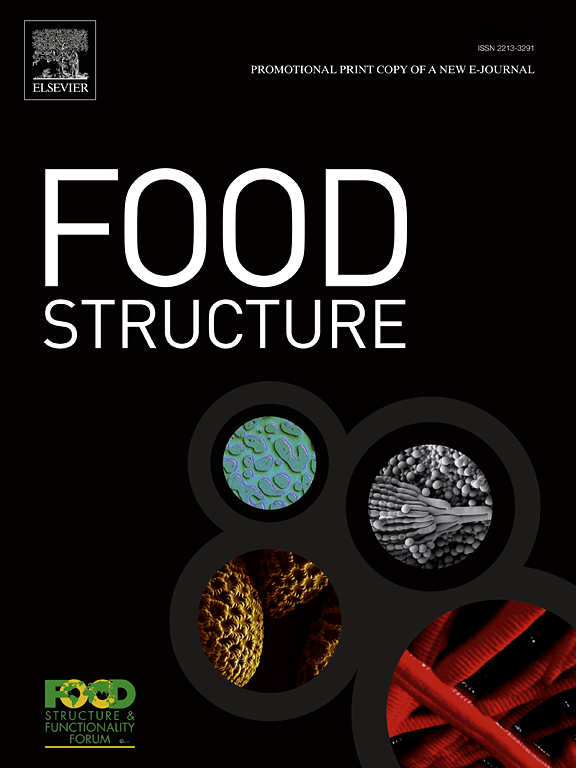Enhancing rheological and textural properties of pea protein-collagen gels via transglutaminase crosslinking
IF 5.6
3区 农林科学
Q1 FOOD SCIENCE & TECHNOLOGY
引用次数: 0
Abstract
Plant-based proteins are gaining attention in the food industry as a healthier and more sustainable alternative to animal proteins due to health concerns, growing global population, water scarcity and climate change. However, controlling their structural and textural characteristics is still a challenge. Combining plant-based proteins with other substances is an effective method for modifying their gelation and textural properties. An enzymatic crosslinking agent, transglutaminase (TG), was herein employed to enhance the gel strength of a mixture consisting of pea protein isolate (PPI) (50 mg/mL) and collagen (3 mg/mL). Rheological oscillatory time sweep analysis showed an enhancement in gel strength of the PPI and collagen gel compared to PPI alone, and even more so after treatment with the cross-linking enzyme. Scanning electron microscopy imaging provided evidence for the formation of gel networks and crosslinks when the protein mixture was treated with low concentrations (2.5 U/mL) of TG, whereas high TG loading (18 U/mL) caused protein phase separation. Sodium dodecyl-sulfate polyacrylamide gel electrophoresis analysis also showed formation of higher molecular weight bands after TG crosslinking. Particle sizes of the PPI and collagen mixture after TG treatment were larger than without TG. In addition, sodium chloride (150 mM) addition significantly improved the gel strength of PPI collagen gels crosslinked by TG. In conclusion, TG with or without salt can be utilized to enhance the strength of PPI and low concentration collagen gels.
通过谷氨酰胺转胺酶交联增强豌豆蛋白-胶原凝胶的流变学和结构特性
由于健康问题、全球人口增长、水资源匮乏和气候变化等原因,植物蛋白作为一种更健康、更可持续的动物蛋白替代品,正日益受到食品行业的关注。然而,控制其结构和质地特性仍是一项挑战。将植物蛋白与其他物质结合是改变其凝胶化和质地特性的有效方法。本文采用一种酶交联剂--转谷氨酰胺酶(TG)来增强由豌豆蛋白分离物(PPI)(50 毫克/毫升)和胶原蛋白(3 毫克/毫升)组成的混合物的凝胶强度。流变振荡时间扫描分析表明,与单独的豌豆蛋白相比,豌豆蛋白和胶原蛋白凝胶的凝胶强度有所提高,而在使用交联酶处理后,凝胶强度的提高幅度更大。扫描电子显微镜成像显示,在使用低浓度(2.5 U/mL)TG 处理蛋白质混合物时,凝胶网络和交联形成,而使用高浓度(18 U/mL)TG 则会导致蛋白质相分离。十二烷基硫酸钠聚丙烯酰胺凝胶电泳分析也显示 TG 交联后形成了较高分子量的条带。经 TG 处理后的 PPI 和胶原蛋白混合物的粒径比未经 TG 处理的要大。此外,氯化钠(150 毫摩尔)的加入也明显提高了经 TG 交联的 PPI 胶原凝胶的凝胶强度。总之,无论是否加盐,TG 都可用于提高 PPI 和低浓度胶原蛋白凝胶的强度。
本文章由计算机程序翻译,如有差异,请以英文原文为准。
求助全文
约1分钟内获得全文
求助全文
来源期刊

Food Structure-Netherlands
Chemical Engineering-Bioengineering
CiteScore
7.20
自引率
0.00%
发文量
48
期刊介绍:
Food Structure is the premier international forum devoted to the publication of high-quality original research on food structure. The focus of this journal is on food structure in the context of its relationship with molecular composition, processing and macroscopic properties (e.g., shelf stability, sensory properties, etc.). Manuscripts that only report qualitative findings and micrographs and that lack sound hypothesis-driven, quantitative structure-function research are not accepted. Significance of the research findings for the food science community and/or industry must also be highlighted.
 求助内容:
求助内容: 应助结果提醒方式:
应助结果提醒方式:


